Zoom
Trash

William Murdoch. William Murdoch (sometimes spelled Murdock) (21 August 1754 – 15 November 1839) was a Scottish engineer and long-term inventor.
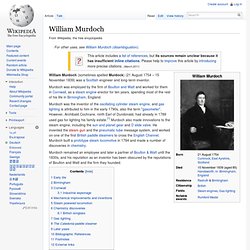
Murdoch was employed by the firm of Boulton and Watt and worked for them in Cornwall, as a steam engine erector for ten years, spending most of the rest of his life in Birmingham, England. Murdoch was the inventor of the oscillating cylinder steam engine, and gas lighting is attributed to him in the early 1790s, also the term "gasometer". However, Archibald Cochrane, ninth Earl of Dundonald, had already in 1789 used gas for lighting his family estate.[1] Murdoch also made innovations to the steam engine, including the sun and planet gear and D slide valve. He invented the steam gun and the pneumatic tube message system, and worked on one of the first British paddle steamers to cross the English Channel. Murdoch built a prototype steam locomotive in 1784 and made a number of discoveries in chemistry.
Early life[edit] William Murdock. ONE of the most interesting chapters in the story of the progress of civilization is that particular one which tells of the coming of :the railway.

With the birth of James Watt, in 1736, the age of steam dawned brightly, but it was not till after William Murdoch was born, eighteen years later, that the locomotive became a tangible idea. To this clever Scotsman belongs the honour of constructing the first steam engine that ever moved on wheels in England and of inventing coal-gas lighting. William Murdoch. William Murdoch - Famous Scots. William's father John (like his father) had been a master gunner with the army.

John was an excellent mechanic and practical engineer. William learned much from his father. While cow herding as a boy he dug coal from a hillside and was fascinated by the imflammable vapours which it gave of when heated - this obsession would prove his road to riches in later life. William Murdoch - The Scot Who Lit The World. William Murdoch biography. William Murdoch was one of this country's great inventors.
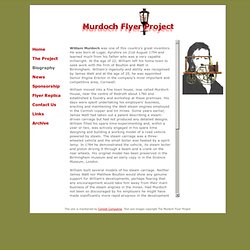
He was born at Lugar, Ayrshire on 21st August 1754 and learned much from his father who was a very capable millwright. History West Midlands. William Murdoch (1754 -1839) was one of most creative and least known figures of the Industrial Revolution.
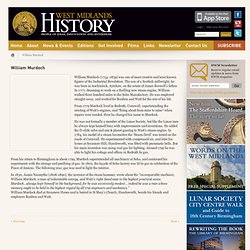
The son of a Scottish millwright, he was born in Auchinleck, Ayrshire, on the estate of James Boswell’s father. In 1777, dreaming to work on a thrilling new steam engine, William walked three hundred miles to the Soho Manufactory. He was employed straight away, and worked for Boulton and Watt for the rest of his life.
From 1779 Murdoch lived in Redruth, Cornwall, superintending the erecting of Watt’s engines, and “flying about from mine to mine” when repairs were needed. Here he changed his name to Murdock. William Murdoch. Murdoch's model.
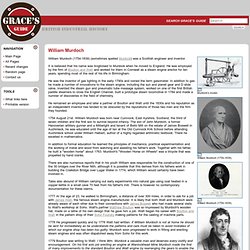
William Murdoch (1754-1839). Murdock's Locomotive 1784. Murdoch's model. 1805. William Murdoch (1754-1839) (sometimes spelled Murdock) was a Scottish engineer and inventor. It is believed that his name was Anglicised to Murdock when he moved to England. William Murdoch. In 1792 he began a series of experiments which resulted in the first practical system of gas lighting anywhere in the world.
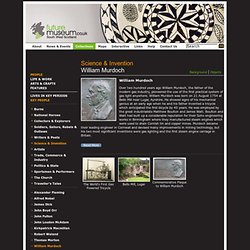
The coal - gas which Murdoch lit his house and offices in Redruth in 1794 was generated in an iron retort at the bottom of his garden, and then piped into his house where he lit the rooms with a variety of burners. His employers did little to encourage this invention until reports that a Frenchman had developed a system of gas lighting using wood or oil prompted Boulton and Watt to exploit Murdoch's invention before the opportunity was lost. It was not though until a Manchester mill owner, George Lee, ordered Murdoch's gas lights for his factory in 1805 that the invention took off. William Murdoch. William Murdoch. The Lunar Men who shaped the future. The Lunar Men who shaped the future. Murdoch House Redruth. William Murdoch was an engineer and inventor who lived in Murdoch House in Redruth from 1782-1798.
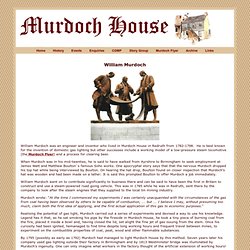
He is best known for the invention of domestic gas lighting but other successes include a working model of a low-pressure steam locomotive (the Murdoch Flyer) and a process for clearing beer. When Murdoch was in his mid-twenties, he is said to have walked from Ayrshire to Birmingham to seek employment at James Watt and Matthew Boulton`s famous Soho works. One apocryphal story says that that the nervous Murdoch dropped his top hat while being interviewed by Boulton.
On hearing the hat drop, Boulton found on closer inspection that Murdoch's hat was wooden and had been made on a lathe!. It is said this prompted Boulton to offer Murdoch a job immediately. William Murdoch went on to contribute significantly to business there and can be said to have been the first in Britain to construct and use a steam-powered road going vehicle. William Murdoch: Inventor and Pioneer - Redruth Tourist Information. William Murdoch - page 1. WILLIAM Murdoch was an inventor who ranked with the best.
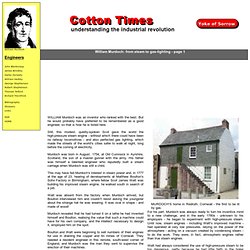
But he would probably have preferred to be remembered as a good engineer, so that is how he is listed here. Still, this modest, quietly-spoken Scot gave the world the high-pressure steam engine - without which there could have been no railway locomotives - and also perfected gas lighting, which made the streets of the world's cities safer to walk at night, long before the coming of electricity. Murdoch was born in August, 1754, at Old Cumnock in Ayrshire, Scotland, the son of a master gunner with the army.
His father was himself a talented engineer who reputedly built a steam carriage when Murdoch was still a child. This may have fed Murdoch's interest in steam power and, in 1777 at the age of 23, hearing of developments at Matthew Boulton's Soho Factory in Birmingham, where fellow Scot James Watt was building his improved steam engine, he walked south in search of a job. Boulton, Watt and Murdoch. Boulton, Watt and Murdoch.

Boulton, Watt and Murdoch. Outside the House of Sport (formerly the Register Office) on Broad Street stands the statue of Boulton, Watt and Murdoch, nicknamed 'The Golden Boys' or 'The Carpet Salesmen'. It is the work of William Bloye, formerly head of sculpture at Birmingham School of Art and was unveiled in 1956, although preliminary designs were drawn up in 1938. The larger than life size figures are in bronze, with a gold finish, on a pedestal of Portland stone and are depicted discussing engine plans.
The piece is in a "temporary" position and was originally intended to stand outside a Planetarium, which was never built, but which would have stood outside what is now the Repertory Theatre. The three men pioneered the industrial revolution in late 18th century England. BBC - Democracy Live - Members' business: William Murdoch, The Scot who lit the world. SNP MSP Adam Ingram led a member's debate on 'William Murdoch, The Scot who lit the world' on 6 November 2012. William Murdoch was born and grew up in the Ayrshire village of Lugar and was responsible for the production of the first steam carriage as well as gas lighting. In his motion Mr Ingram welcomes the celebrations surrounding the 200th anniversary of the gas industry and, in particular, the opportunity to recognise the contribution made by William Murdoch, 1754-1839.
SNP MSP Adam Ingram said that William Murdoch was "an engineering genius" and this placed him "in the pantheon of the great pioneers of the first industrial revolution" He also said that "In these days of the puerile celebrity culture he is as role model that deserves to be promoted to our young people today". Pneumatic tube. A small number of pneumatic transportation systems were also built for larger cargo, to compete with more standard train and subway systems.
However, these never gained popularity. History[edit] Historical use[edit] Pneumatic tubes in use at a drive-through bank.